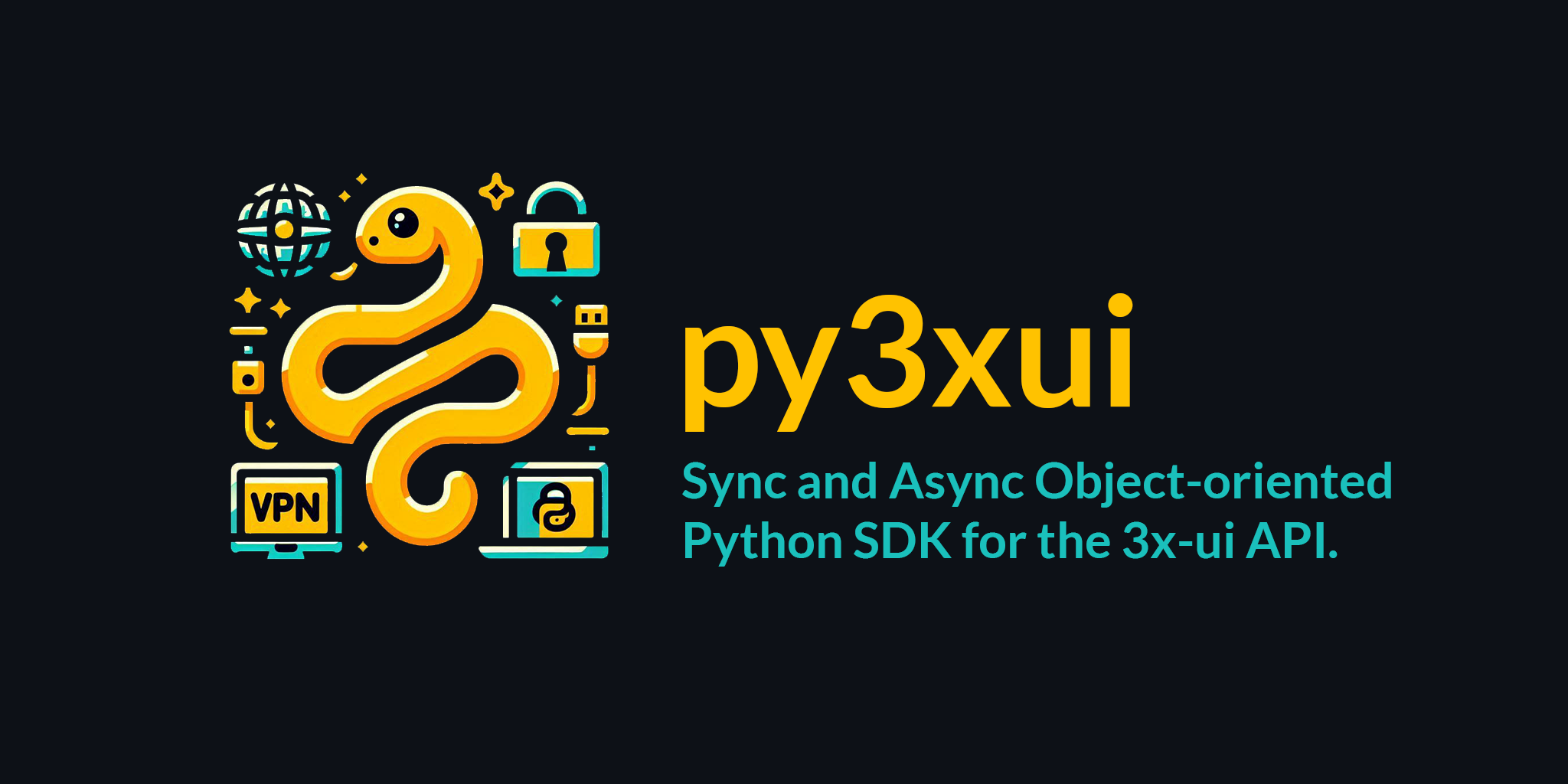Sync and Async Object-oriented Python SDK for the 3x-ui app.
Project description

Sync and Async Object-oriented Python SDK for the 3x-ui API.
Overview • Compatibility Table • Quick Start • Examples • Bugs and Feature Requests • PyPI
Overview
This SDK is designed to interact with the 3x-ui app in a more object-oriented way. It provides both synchronous and asynchronous methods to interact with the app. The SDK is designed to be as simple as possible to use, while still providing a lot of flexibility and uses Pydantic models to validate the data.
Used dependencies:
requestsfor synchronous APIhttpxfor asynchronous APIpydanticfor models
Supported Python versions:
- 3.11
- 3.12
Compatibility Table
Since the 3x-ui app is under development, the SDK may not be compatible with all versions of the app. The table below shows the compatibility between the SDK and the 3x-ui app. Since the developer of SDK is not related to the 3x-ui app, the latest versions of the software are not guaranteed to be compatible with the SDK. It's recommended to use the specified versions of the software to avoid any issues.
| py3xui Version | 3x-ui Version |
|---|---|
| >=0.2.2 | >=2.3.9, <=2.3.11 |
| 0.2.1 | >=2.3.7 |
The SDK does not support older versions of the 3x-ui app.
Quick Start
You can use both synchronous and asynchronous methods to interact with the 3x-ui app. Both APIs have the same methods and return the same data, so it's up to you to choose which one to use.
After installing the SDK, you can create a new instance of the API. When creating a new instance, you can either use environment variables or pass the credentials directly. It's strongly recommended to use environment variables to store the API credentials.
On creation, the Api won't connect to the 3x-ui app, so you can spawn new instances without spending resources. But after creating an instance, you'll need to call the login method to authenticate the user and save the cookie for future requests.
Installation
pip install py3xui
Create a new instance of the SDK
It's recommended to use an environment variable to store the API credentials:
import os
os.environ["XUI_HOST"] = "http://your-3x-ui-host.com:2053"
os.environ["XUI_USERNAME"] = "your-username"
os.environ["XUI_PASSWORD"] = "your-password"
To work synchronously:
from py3xui import Api
# Using environment variables:
api = Api.from_env()
# Or using the credentials directly:
api = Api("http://your-3x-ui-host.com:2053", "your-username", "your-password")
To work asynchronously:
from py3xui import AsyncApi
# Using environment variables:
api = AsyncApi.from_env()
# Or using the credentials directly:
api = AsyncApi("http://your-3x-ui-host.com:2053", "your-username", "your-password")
*️⃣ If you're using a custom URI Path, ensure that you've added it to the host, for example:
If your host is http://your-3x-ui-host.com:2053 and the URI Path is /test/, then the host should be http://your-3x-ui-host.com:2053/test/.
Otherwise, all API requests will fail with a 404 error.
Login
No matter which API you're using or if was it created using environment variables or credentials, you'll need to call the login method to authenticate the user and save the cookie for future requests.
from py3xui import Api, AsyncApi
api = Api.from_env()
api.login()
async_api = AsyncApi.from_env()
await async_api.login()
Examples
You'll find detailed docs with usage examples for both APIs and for used models in the corresponding package directories:
In this section, you'll find some examples of how to use the SDK. In the examples, we'll use the synchronous API, but you can use the asynchronous API in the same way, just remember to use await before calling the methods.
Get inbounds list
from py3xui import Api, Inbound
api = Api.from_env()
api.login()
inbounds: List[Inbound] = api.inbound.get_list()
Add a new inbound
from py3xui import Api
from py3xui.inbound import Inbound, Settings, Sniffing, StreamSettings
api = Api.from_env()
api.login()
settings = Settings()
sniffing = Sniffing(enabled=True)
tcp_settings = {
"acceptProxyProtocol": False,
"header": {"type": "none"},
}
stream_settings = StreamSettings(security="reality", network="tcp", tcp_settings=tcp_settings)
inbound = Inbound(
enable=True,
port=443,
protocol="vless",
settings=settings,
stream_settings=stream_settings,
sniffing=sniffing,
remark="test3",
)
api.inbound.add(inbound)
Get a client by email
from py3xui import Api, Client
api = Api.from_env()
api.login()
client: Client = api.client.get_by_email("some-email")
Add a new client
from py3xui import Api, Client
api = Api.from_env()
api.login()
new_client = Client(id=str(uuid.uuid4()), email="test", enable=True)
inbound_id = 1
api.client.add(inbound_id, [new_client])
Bugs and Feature Requests
If you find a bug or have a feature request, please open an issue on the GitHub repository.
You're also welcome to contribute to the project by opening a pull request.
Project details
Release history Release notifications | RSS feed
Download files
Download the file for your platform. If you're not sure which to choose, learn more about installing packages.
Source Distribution
Built Distribution
File details
Details for the file py3xui-0.2.3.tar.gz.
File metadata
- Download URL: py3xui-0.2.3.tar.gz
- Upload date:
- Size: 27.8 kB
- Tags: Source
- Uploaded using Trusted Publishing? No
- Uploaded via: twine/5.1.1 CPython/3.12.5
File hashes
| Algorithm | Hash digest | |
|---|---|---|
| SHA256 | 6e47f4ba32814c62c1fe8f7e6c7dd0257f2ddbd8e8dce697f33f53a944b9db01 |
|
| MD5 | 0528161afcb84eb0bae2f2625d861260 |
|
| BLAKE2b-256 | 8e93659edce0acb9008a76addbc8d4f8fb55fceb20094deb1fb7e9570e406263 |
File details
Details for the file py3xui-0.2.3-py3-none-any.whl.
File metadata
- Download URL: py3xui-0.2.3-py3-none-any.whl
- Upload date:
- Size: 34.4 kB
- Tags: Python 3
- Uploaded using Trusted Publishing? No
- Uploaded via: twine/5.1.1 CPython/3.12.5
File hashes
| Algorithm | Hash digest | |
|---|---|---|
| SHA256 | 841785bd5b529db02c18ed315fd26bcc57e7bfdf5eeec48bba24f5679af2cc56 |
|
| MD5 | 2d48ad711184133cc8d973c23d3a42dc |
|
| BLAKE2b-256 | 67a38e757caa5c0408a94a91ae4af666ef04c3e1e16c39ff7e05a6a3d430da7e |




















